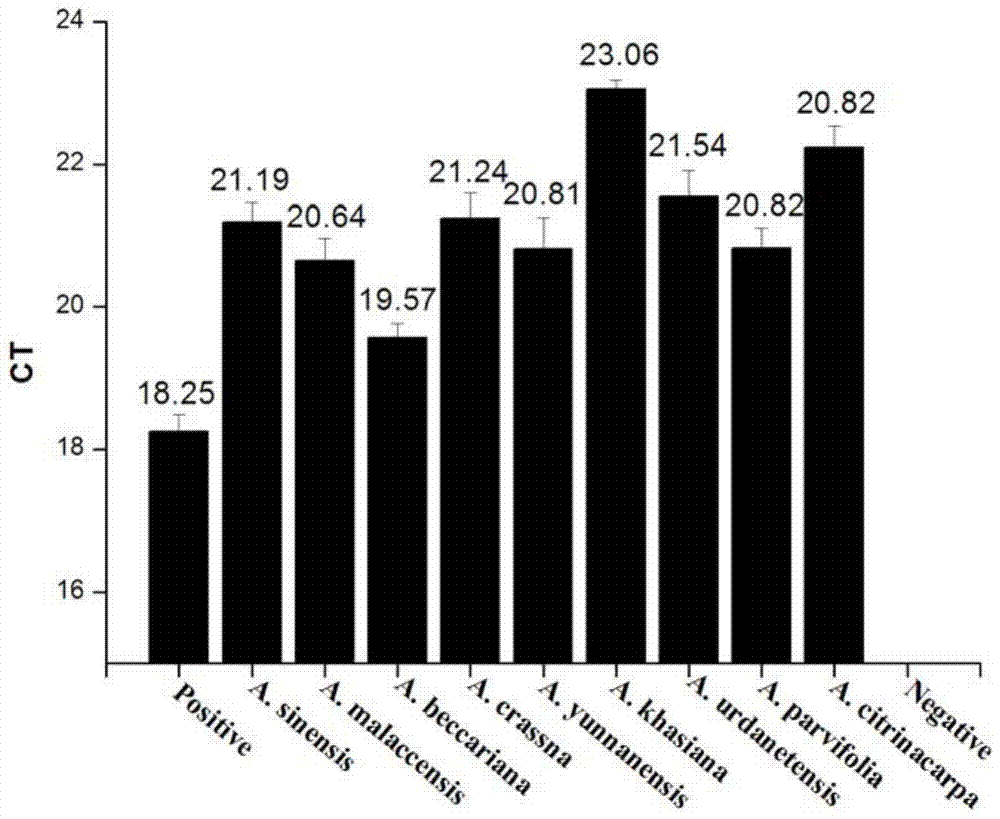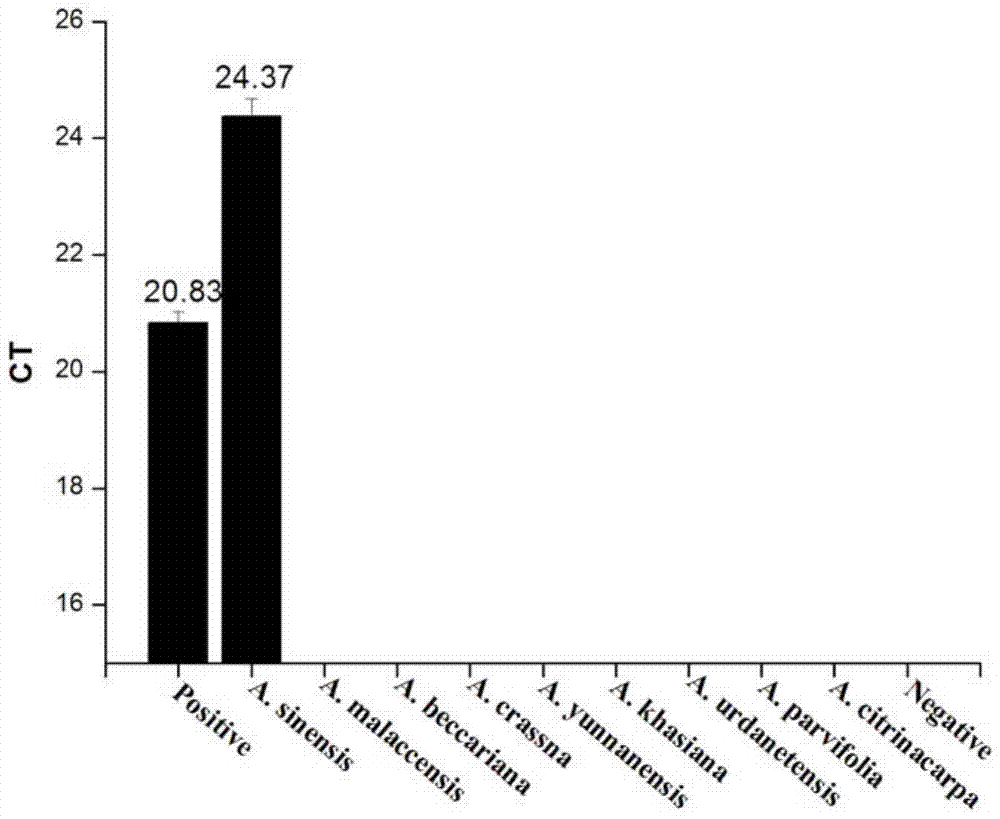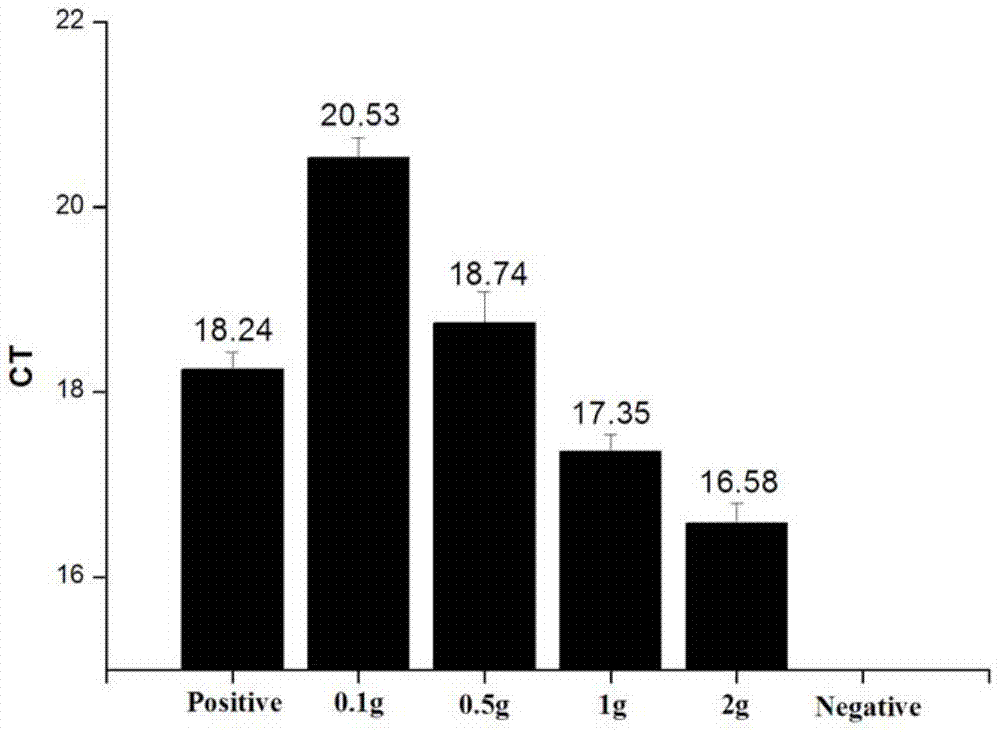Fluorescence quantitative pcr method, primers and probes for identification of arborina officinalis and their application
A fluorescence quantification, white wood incense technology, applied in the field of DNA identification of white wood incense, primers and probes, can solve the problems of difficult wood identification accuracy, similar material structure, etc., to achieve the effect of easy unified standards, intuitive analysis, and simple operation
- Summary
- Abstract
- Description
- Claims
- Application Information
AI Technical Summary
Problems solved by technology
Method used
Image
Examples
Embodiment 1
[0032] Example 1 Primers, probes and detection kits for detection of A. sinensis
[0033] Use resource information such as NCBI to find out the gene difference sites between A. chinensis and other woods, and screen out a pair of specific amplification primers (bmx Primer-F and bmx Primer-R). A specific probe (bmx Primer Probe) is set. The amplification primer pair and the probe sequence are respectively:
[0034] bmx Primer-F: 5'-GAAACTTACATACAAAGTCGTCCCTTC-3'
[0035] bmx Primer-R: 5'-CATTACCAAGACATCATCCTCATTTT-3'
[0036] bmx Primer Probe: 5'-VIC-TGACATAGACACAAGTC-MGB-3'.
[0037] The invention discloses a kit for detecting arborina, which includes a sample DNA extraction reagent, a qPCR amplification reaction solution, a positive control substance, a negative control substance and a blank control substance.
[0038] Wherein the qPCR amplification reaction system is: 20 µl system includes:
[0039] Taqman gettyping master mix (2×) 10µl
[0040] bmx Primer Probe final c...
Embodiment 2
[0051] Embodiment 2: the identification method of real-time fluorescent PCR
[0052] (1) Pretreatment of wood samples:
[0053]Thoroughly disinfect the wood surface with 75% ethanol, rinse with sterile water and wipe the wood dry. Cut off the surface of the wood to be tested to avoid contamination by other organizations. Take a certain amount of wood samples, add liquid nitrogen and quartz sand to a pre-cooled mortar and grind them into powder for later use. When not used immediately, the sample DNA solution was stored at -20°C until use.
[0054] (2) DNA extraction of wood samples:
[0055] The total DNA of the pretreated wood in step (1) was extracted using Plant Genomic DNA Kit (TIANGEN), and placed in a -40°C refrigerator for later use.
[0056] (3) Real-time fluorescent PCR amplification:
[0057] The DNA extracted in step (2) was subjected to qPCR detection. The amplification conditions are: 95°C for 10 min; 95°C for 15 s, 60°C for 1 min, a total of 40 cycles. The...
Embodiment 3
[0064] Embodiment 3: DNA extraction and detection
[0065] A. chinensis (experimental group 1), control group: A. malaccensis (Malay agarwood); A. beccariana (Northern agarwood); A. crassna; A. urdanetensis; A. yunnanensis (Yunnan agarwood); A. khasiana; A. parvifolia; A. citrinacarpa A total of 8 control genomic DNAs were used as templates, and the extracted DNA was detected by using the plant endogenous gene tRNALeu and the reaction system in Example 1 and the detection method described in Example 2.
[0066] The primer and probe sequences for tRNALeu are (standard)
[0067] tRNALeu-F: 5'-CGAAATCGGTAGACGCTACG-3'
[0068] tRNALeu-R: 5'-TTCCATTGAGTCTCTGCACCT-3'
[0069] tRNALeu Probe: 5'-FAM-GCAATCCTGAGCCAAATCC-TAMRA-3'
[0070] Such as figure 1 It shows that the DNA of the samples of the experimental group and the control group in Example 3 have been successfully extracted.
PUM
 Login to View More
Login to View More Abstract
Description
Claims
Application Information
 Login to View More
Login to View More - R&D
- Intellectual Property
- Life Sciences
- Materials
- Tech Scout
- Unparalleled Data Quality
- Higher Quality Content
- 60% Fewer Hallucinations
Browse by: Latest US Patents, China's latest patents, Technical Efficacy Thesaurus, Application Domain, Technology Topic, Popular Technical Reports.
© 2025 PatSnap. All rights reserved.Legal|Privacy policy|Modern Slavery Act Transparency Statement|Sitemap|About US| Contact US: help@patsnap.com



